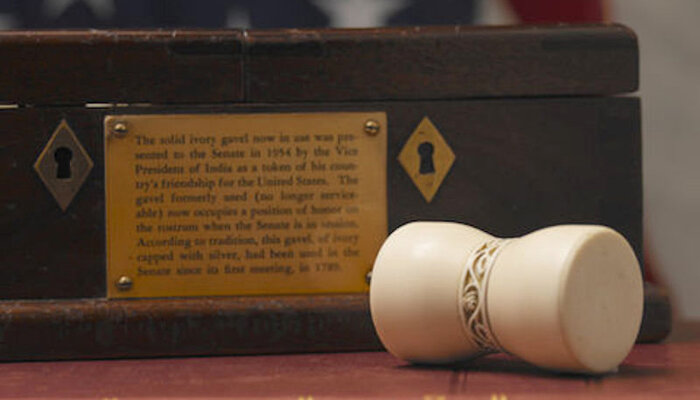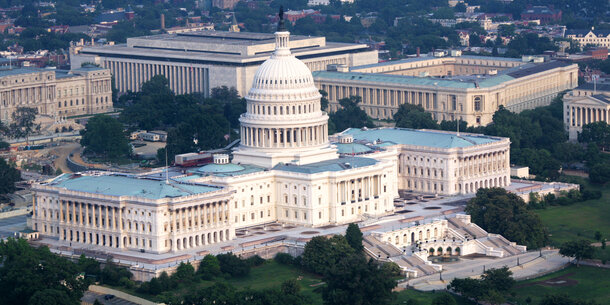Absent from the Constitution and Early Congresses
Some Americans mistakenly believe the filibuster originated with the 1789 Constitution and was part of the
framers’ plan for how the Senate should function. It plainly was
not. The Constitution leaves it up to each house of Congress to set its own rules. Indeed, the framers considered
and rejected the idea of requiring supermajorities for legislation. As Alexander Hamilton wrote in
Federalist 22, “To give a minority a negative upon the majority (which is always the case where more
than a majority is requisite to a decision), is, in its tendency, to subject the sense of the greater number to that
of the lesser.” They knew such built-in obstruction could doom a republic.
Tellingly, the filibuster did not become a rule or practice of the Senate until 129 years after the Constitution was
ratified. Moreover, not only is the Constitution silent on the matter, but it prescribes supermajority votes only
for very specific subjects, such as treaties, making clear that a simple majority is the expectation for other
circumstances, including legislation. This indicates that supermajorities, as required by the filibuster, are
otherwise disfavored.
In the years immediately following ratification of the Constitution, the Senate functioned under majoritarian rule.
Before 1806, the Senate followed a rule allowing debate to be brought to a close by a simple majority of the body. Apparently by mistake, the Senate eliminated the rule shortly
after but nonetheless did not experience a filibuster for 30 years, indicating that it was not a practice of the
early Senate.
It was not until the 1850s that the term filibuster was employed in reference to stem-winding speeches by
senators intending to push back the timing of a vote, either because they sought to kill a bill or gain other
leverage. But even then the filibuster was rarely used, as it required
senators to physically stay on the Senate floor and continue their speechmaking, a tactic difficult to sustain for
any great length of time. Its impact was therefore limited, perhaps causing some delays but not derailing
legislation opposed by the filibustering senators — which might explain why “almost every filibustered
measure before 1880 was eventually passed.”
An Innovation for Obstruction
It was only at the close of the 19th century that filibusters began to make a difference in legislative outcomes. Senators realized that the filibuster could thwart disfavored bills. In
turn, other senators and outside reformers demanded that Senate rules be changed to allow a simple majority to
determine legislative outcomes.
This conflict came to a head in 1891 after a series of filibusters by Democrats threatened to derail legislation
authorizing federal troops to supervise federal elections — an early use of the tool to block civil rights
protections for Black Americans. Seeking to cut off debate, Republican leaders appealed to Vice President Levi
Morton to rule on whether a majority could bring debate to a close and proceed to a vote. At that time, the Senate had yet to adopt any provision to end debate — in
other words, to bring a filibuster to a close — because the filibuster’s use had been so rare. Sen.
George Edmunds (R-VT) defended what would become the cloture rule, explaining, “The Constitution . . .
necessarily implies that no minority, whether of one or any other number, should or could unduly obstruct the
expression of the will of the majority. Edmunds’s proposal
did not pass. But during World War I, a filibuster by what President
Woodrow Wilson decried as a “little group of willful men” against legislation seeking to arm U.S.
merchant ships against German attacks caused an outcry for reform. Wilson made clear his strong support for a change to Senate rules, lamenting that
“the Senate of the United States is the only legislative body in the world which cannot act when its majority
is ready for action.”
Proponents of reform continued to make the point that the Constitution left it to the Senate to set its own rules by
a majority vote at the beginning of each new Congress — allowing members to change the rule so that a mere
majority could win a vote. Sen. Thomas Walsh (D-MT) explained to the
chamber that the Constitution gave each house the power to set its own rules, something done by the House of
Representatives each Congress via a majority vote. Indeed, he argued, the case was even stronger for the Senate,
since it is a “continuing body,” whereby some senators remain even while others are up for reelection.
“A majority may adopt the rules, in the first place. It is preposterous to assert that they may deny future
majorities the right to change them.” It would be unconstitutional,
Walsh argued, for a Senate rule to thwart the ability of future Senates to set their own rules. Soon afterward, in 1917, the Senate adopted the cloture rule, allowing a vote to bring
debate to a close and end a filibuster. While Walsh’s arguments
were never formally considered, the idea that the Senate could rule by majority no doubt had an impact on the
adoption of the cloture rule. At that time, the Senate chose not to adopt a strict majority rule, instead requiring
two-thirds of the senators present to vote for cloture to end debate. Nonetheless, the adoption of the cloture vote
demonstrated the Senate could change its rules to prevent obstructive tactics. Cloture votes were quite unusual for the next half century, with just 37 between 1917
and 1967.
Starting in the late 1950s, senators began to use the filibuster to thwart passage of civil rights legislation
intended to address the deeply entrenched racism that affected so many areas of American life. Anti–civil rights Dixiecrats obstructed anti-lynching bills; bills prohibiting
poll taxes; and bills prohibiting discrimination in employment, housing, and voting. Most notable were their filibusters of the most significant civil rights bills in
United States history: the Civil Rights Acts of 1957 and 1964. Then-Democratic Sen. Strom Thurmond held the floor
against the 1957 act without a break for 24 hours and 18 minutes. Even
longer, the filibuster against the Civil Rights Act of 1964 went on for 74 days, although it was ultimately
unsuccessful.
Despite this shameful track record, the Senate did not reform the filibuster again until 1974. By that time, its use
had become more widespread as senators sought to delay and derail an array of bills that went beyond civil rights. Before 1966, there was an average of five filibusters per year. That
number grew to 10 between 1971 and 1973, and reached 18 by 1974. As part
of a post-Watergate demand for reforms, including changes to ethics laws and campaign finance limits, senators
adopted a new cloture rule. While not the straight majority vote favored by some reformers, Democratic Sen. Walter Mondale of Minnesota compromised with Republican Sen.
James Pearson of Kansas to decrease the necessary vote for cloture from two-thirds to three-fifths of the body
— in other words, from 67 votes to 60, the current rule for legislation. The move required a sympathetic vice president (Nelson Rockefeller) and a majority
willing to uphold his ruling. The push took a month and eventually prevailed by 56–27.
Undercutting this reform, however, the Senate contemporaneously adopted a rule that gave the filibuster new strength.
No longer would a filibuster delay all Senate business. Instead, new Senate procedure would create a dual-tracking
system that allowed the body to toggle between different bills so that a bill facing a filibuster was “kept on
the back burner” until a vote for cloture could be successful. This
meant that no one observing the Senate would likely realize that a bill was being filibustered, since no one had to
take the floor and stay there. This significantly reduced the public relations disincentive to filibuster and made
it practically invisible to the public and the media. The talking filibuster had died; all a senator needed to do
was indicate an intention to filibuster in order to move a bill to the end of the queue or “the back
burner.”
Another reason the filibuster remained a forceful tool despite a reduction in the number of votes required to invoked
cloture is that breaking a filibuster takes time. The Senate moves legislation through a series of motions, each of
which can be filibustered. The first motion, the “motion to proceed,” allows the first bite at the
apple. By filibustering a motion to proceed — the motion that begins consideration of a measure — an
obstructionist can kill a bill early, avoiding all public debate. What’s more, one successful cloture vote
does not clear the way for passage. Senators committed to killing a bill can filibuster a given bill at six
different points in the legislative process. Each cloture petition must
sit for two days before a vote, and if cloture is invoked with the 60 votes required, debate on the bill can take up
to 30 hours subsequent to the cloture vote. Senate leaders have found that the risk of losing so much time spent
waiting for cloture to “ripen” is reason to avoid debating legislation. In fact, most bills are blocked long before they even reach the Senate floor.
In today’s Senate, any bill in practice, if not formally, requires 60 votes to proceed.
Gross Obstruction in the 21st Century
Since the 1970s, use of the filibuster has mushroomed and become the normal practice of the Senate, not the
exception. Cloture motions have skyrocketed since 2006, doubling from that year to the next and reaching an all-time
high in the current Senate. There have been as many cloture motions in
the last 10 years (959) as there were during the 60-year period from 1947 to 2006 (960).
This development has occurred without it being apparent to observers, as the end of the talking filibuster means a
senator can derail legislation simply by indicating that he or she will raise an objection to the motion to proceed,
which triggers the need for 60 votes for cloture. Since each cloture vote consumes valuable time in the Senate, the
mere threat of an objection is often enough to remove a bill from the queue. As a result, the increasing use of the
filibuster has diminished the productivity of the Senate and also shaped its legislative agenda — all at the
expense of democracy.



